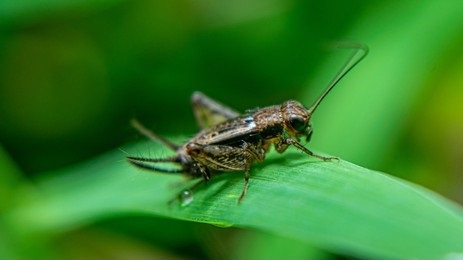Crickets belong to the Orthoptera, Gryllidae, and there are about 900 species of crickets worldwide, which feed on plant stems, leaves, seeds, and roots and are agricultural pests. However, it can be easily reproduced in the laboratory and is widely used to study insect physiology and neurobiology, and the species has been established as a model system for studying the molecular mechanisms of development and regeneration.
Insects can use water and food more efficiently than conventional livestock, exhibiting lower feed conversion rates and better growth efficiency. For example, crickets consume six times and three times more feed than cattle and pigs, respectively, to produce the same amount of protein. In addition, crickets emit fewer greenhouse gases and ammonia than conventional livestock and can be raised on organic by-products, such as food waste or by-products from the agricultural and food industries.

Despite these advantages, crickets have not been used for food and feed because insect farming is not considered cost-effective. Therefore, efficient harvesting, large-scale production systems, and selective breeding are needed to ensure safe, sustainable, and reliable cricket production.
With the completion of cricket genome sequencing, a breakthrough in the functional resolution of related genes has been achieved by providing new information to support an in-depth understanding of cricket growth, development, metamorphosis, evolution, and reproduction. In the post-genomic era, genome editing to elucidate various scientific questions about crickets has become an important tool for their research.
Lifeasible has demonstrated the possibility of gene knockout in crickets, and we have generated stable and efficient knockout lines (e.g., knockout of Gb'lac2, Dop1 genes) through CRISPR/Cas9-mediated gene-editing system to provide technical services for cricket gene function research and production. Our approach can be used for functional genomics of crickets, disruption of specific coding sequences, and targeting of regulatory elements in the genome.
Lifeasible knocked out the target gene by CRISPR/Cas9 system by first designing a gRNA targeting the target gene sequence, then injecting Cas9 mRNA and gRNA transcribed by in vitro transcription into cricket eggs and incubating, hybridizing, and testing to obtain the knockout system.
 Figure 1. Summary of the scheme to isolate homozygous mutants in the cricket. (Watanabe T., et al., 2017)
Figure 1. Summary of the scheme to isolate homozygous mutants in the cricket. (Watanabe T., et al., 2017)
The CRISPR/Cas9-mediated gene editing system established by Lifeasible can be used to modify genes responsible for deleterious traits in crickets, for example, disrupting genes that promote pathogen transmission, or editing regulatory regions of cis-gene. Knocking out specific genes in the cricket genome using CRISPR/Cas9-mediated gene editing will help identify new approaches to address the challenges posed by crickets while avoiding the use of transgenic approaches. For more information or any inquiry requirements, please contact Lifeasible.
References:
Lifeasible has established a one-stop service platform for plants. In addition to obtaining customized solutions for plant genetic engineering, customers can also conduct follow-up analysis and research on plants through our analysis platform. The analytical services we provide include but are not limited to the following:
STU-CRISPR System Improves Plant Genome Editing Efficiency
April 19, 2024
Application of Exosomes in Facial Beauty
April 12, 2024